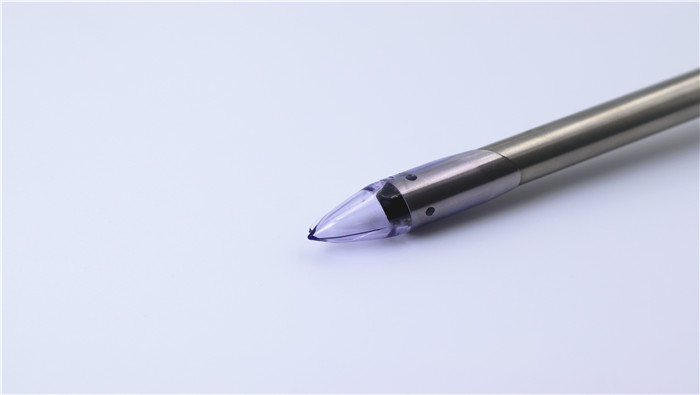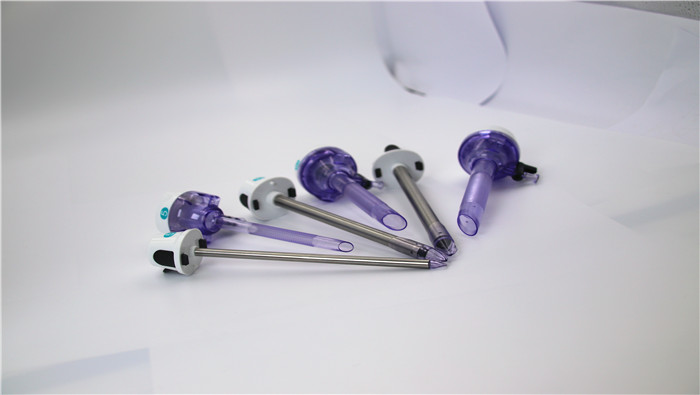

Sterilization is the core process to ensure the safety and effectiveness of single-use laparoscopic trocars, and its validation needs to cover multiple dimensions, such as the suitability of the sterilization method, the robustness of the process parameters, the control of residues, and the protection of material properties. Based on ISO 11135 (ethylene oxide sterilization), ISO 11137 (irradiation sterilization) and other international standards, this paper systematically describes the key elements of sterilization validation.

I. Validation of the suitability of sterilization methods
Evaluation of material resistance
Ethylene oxide (EtO) sterilization: applicable to polycarbonate (PC), ABS and other common penetrator materials, need to verify the stability of the material performance after repeated sterilization (e.g., tensile strength degradation of ≤5%).
Gamma ray sterilization: may lead to some polymer materials (such as PC) slight yellowing or embrittlement, need to be detected by FTIR (Fourier Transform Infrared Spectroscopy) molecular chain breakage.
E-beam sterilization: weak penetration, need to verify the uniformity of dose distribution (dose inhomogeneity ≤ 1.5), to avoid local overheating caused by material deformation.
Selection of sterilization method is based on
Complexity of instrument structure: for penetrators with multiple lumens or internal metal components, EtO sterilization is preferred to ensure adequate penetration of the sterilizing agent.
Batch size: Gamma radiation is suitable for large batches, whereas E-beam is more suitable for small batches or thin-walled instruments.
II. Validation of Sterilization Process Parameters
Definition of Key Parameters
Temperature and Humidity: EtO sterilization requires a controlled temperature of 50-60°C and a humidity of 40-80% RH, which may affect the spread of the sterilizing agent or the properties of the material.
Sterilization dose: half-cycle method or incremental dose method to determine the minimum sterilization dose (such as initial contamination bacteria ≤ 100 CFU / piece, the conventional dose of 25kGy).
Exposure time: EtO sterilization exposure time is usually 2-6 hours, which needs to be combined with a biological indicator (Bacillus subtilis black variant spores) to confirm the sterilization effect.
Process window validation
Establish the parameter design space (Design Space) to verify the effectiveness of sterilization under the fluctuation of temperature ±5℃ and humidity ±15%RH (SAL≤10-⁶).

III. Sterilization residue control validation
Ethylene oxide residue limit
EO residue: according to ISO 10993-7, EO residue in finished products ≤4μg/g, ECH (epichlorohydrin) ≤9μg/g.
Resolution process optimization: forced ventilation resolution (50℃/humidity 30-60% RH) for more than 48 hours, combined with dynamic air exchange to reduce residue.
Irradiation by-product detection
Gamma sterilization may produce trace formaldehyde (POM degradation product), which should be detected by headspace gas chromatography (concentration ≤10ppm).
IV. Material and Functional Performance Verification
Material Mechanical Performance Testing
Puncture Core Strength: ≤10% change in puncture force before and after sterilization (refer to ASTM F1717).
Rigidity of cannula: modulus of elasticity attenuation ≤5% to ensure intraoperative resistance to torsional load.
Sealing validation
Post-sterilization gas-tightness test (leakage rate ≤1 mL/min at 15 mmHg pressure) to ensure that the sealing function of the cannula valve body has not been compromised.
Dimensional Stability
Three-dimensional optical scanning to detect critical dimensions (e.g., cannula OD, puncture core tip angle) with linear expansion ≤ 0.1%.
V.Sterilization Packaging Integrity Verification
Packaging Material Compatibility
Verify the sealing strength of the dialysis paper/plastic film combination after sterilization (heat seal strength ≥ 3.5N/15mm, ASTM F88 standard).
Accelerated Aging Test
Storage at 70°C/75%RH for 30 days to simulate a 3-year expiration date to detect package integrity and device performance degradation.
Microbial barrier test
Based on ISO 11607 standard, to verify the sterilization packaging bacterial barrier (challenge test pass rate 100%).
VI.Sterilization Process Compliance Verification
Bioindicator Challenge
Bioindicators are placed in each sterilization batch to verify the killing effect at the cold spot location in the sterilization chamber (viable spores ≤ 10-⁶).
Chemical Indicator Application
Real-time monitoring of sterilant concentration, temperature and humidity, and permeation uniformity using Class 5 chemical indicator cards (multiparameter indicator cards).
Process Data Traceability
Sterilization process parameters (temperature, humidity, pressure, dosage) should be recorded throughout the process and stored until 2 years after the product expiration date.

VII.Production consistency verification
Batch-to-batch stability
3 consecutive batches of test production products, performance deviation before and after sterilization ≤ 5%, bioburden ≤ 100 CFU/piece.
Process capability analysis
Key parameters CPK ≥1.67 (e.g. sterilization temperature control accuracy ±1℃) to ensure the robustness of mass production.
Conclusion
Sterilization validation of disposable laparoscopic trocars requires the construction of a “method-process-material-packaging” whole chain quality control system, with the core focus on balancing sterilization efficacy and material protection. Enterprises should prioritize the use of international standards (e.g., ISO, ASTM) as the validation benchmarks, and at the same time combine digital monitoring (e.g., MES system) to improve process controllability. In the future, research on the compatibility of new technologies such as low-temperature plasma sterilization with polymer materials will provide better solutions for the industry.
+86 18361958211
marketing@cndonho.com
+86 18361958211
No.2 Zhiwei Road, Qiandeng Town, Kunshan City, Jiangsu Province, China




